Clinical Leadership in Nursing: Styles, Outcomes, and Recommendations
VerifiedAdded on 2023/03/17
|9
|2606
|69
Report
AI Summary
This report provides an in-depth analysis of clinical leadership in nursing, focusing on the impact of various leadership styles on patient outcomes and nursing practices. The paper begins with an introduction to the significance of effective nursing leadership in healthcare, emphasizing its role in improving patient care quality and safety. It then reviews four research articles, each examining different leadership styles, including transformational, transactional, and autocratic approaches, within diverse clinical settings such as emergency units and intensive care units. The analysis includes a discussion of the leadership styles, recommendations, and limitations presented in the articles. The report highlights the benefits of transformational leadership in enhancing patient safety, promoting innovation among nursing professionals, and fostering a positive work environment. It contrasts transformational leadership with transactional and autocratic styles, pointing out the potential drawbacks of the latter, such as decreased job satisfaction and limited critical thinking. The report concludes by emphasizing the importance of transformational leadership in nursing and suggesting areas for future research and practical implications for leadership development.
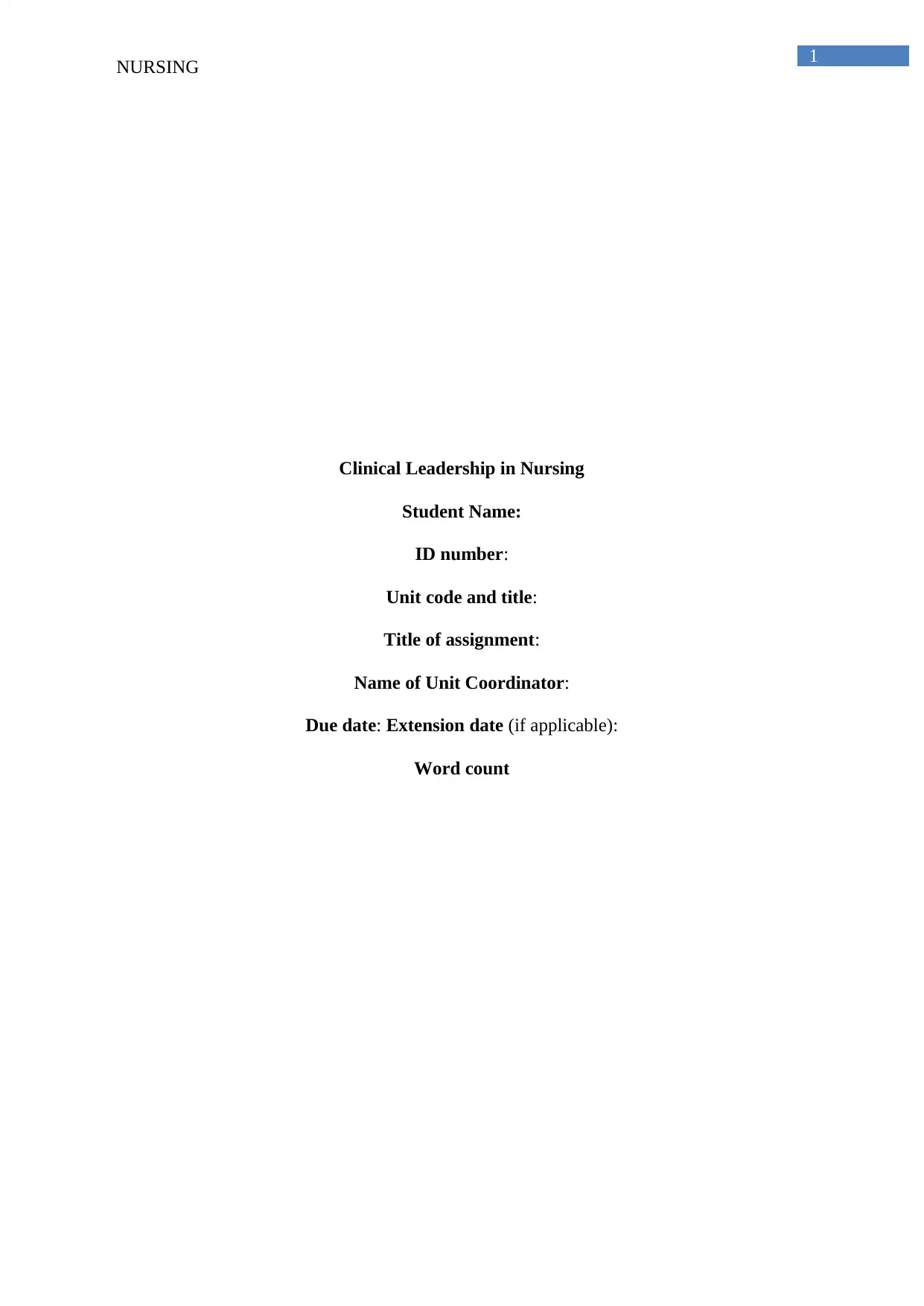
1
NURSING
Clinical Leadership in Nursing
Student Name:
ID number:
Unit code and title:
Title of assignment:
Name of Unit Coordinator:
Due date: Extension date (if applicable):
Word count
NURSING
Clinical Leadership in Nursing
Student Name:
ID number:
Unit code and title:
Title of assignment:
Name of Unit Coordinator:
Due date: Extension date (if applicable):
Word count
Paraphrase This Document
Need a fresh take? Get an instant paraphrase of this document with our AI Paraphraser
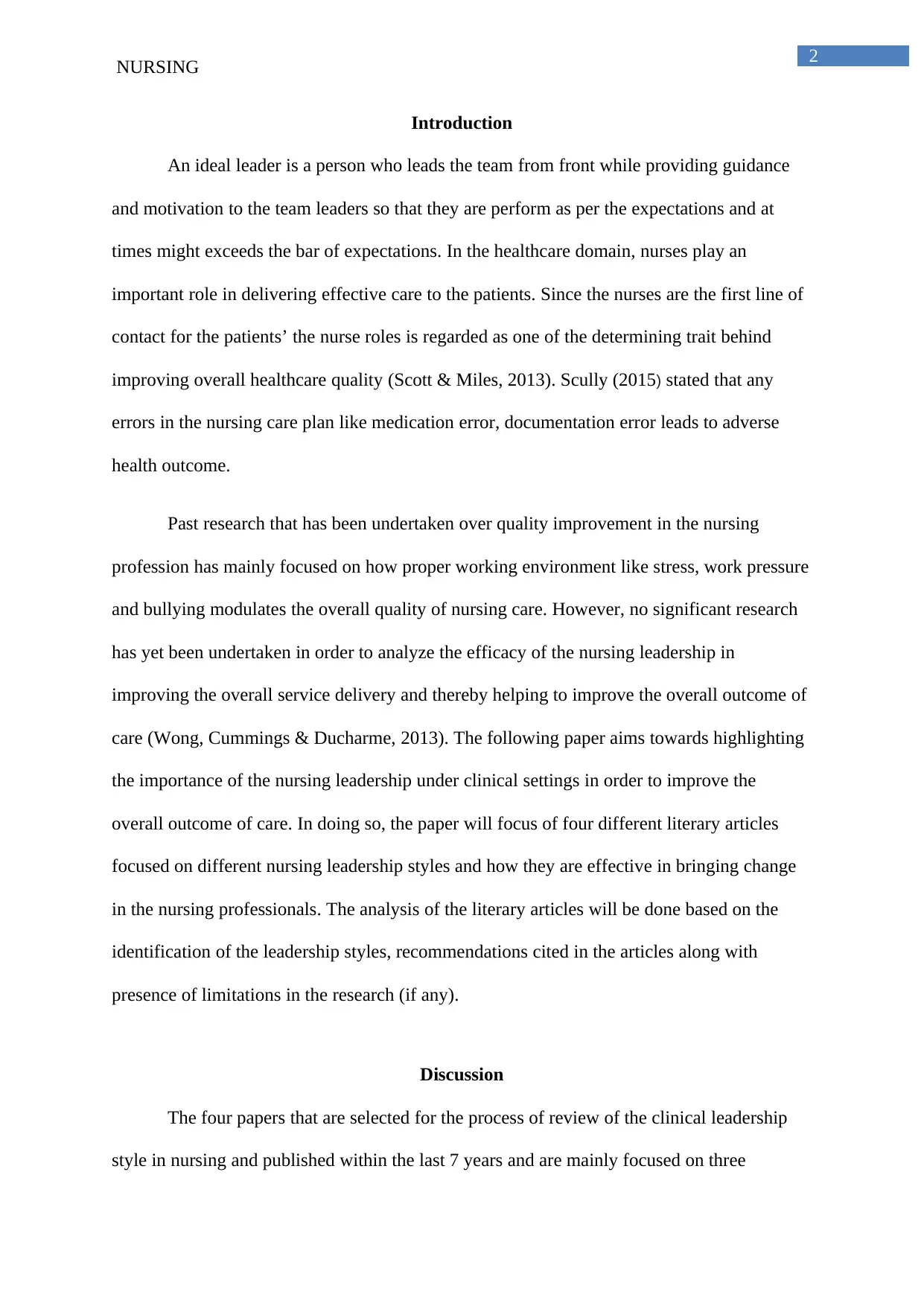
2
NURSING
Introduction
An ideal leader is a person who leads the team from front while providing guidance
and motivation to the team leaders so that they are perform as per the expectations and at
times might exceeds the bar of expectations. In the healthcare domain, nurses play an
important role in delivering effective care to the patients. Since the nurses are the first line of
contact for the patients’ the nurse roles is regarded as one of the determining trait behind
improving overall healthcare quality (Scott & Miles, 2013). Scully (2015) stated that any
errors in the nursing care plan like medication error, documentation error leads to adverse
health outcome.
Past research that has been undertaken over quality improvement in the nursing
profession has mainly focused on how proper working environment like stress, work pressure
and bullying modulates the overall quality of nursing care. However, no significant research
has yet been undertaken in order to analyze the efficacy of the nursing leadership in
improving the overall service delivery and thereby helping to improve the overall outcome of
care (Wong, Cummings & Ducharme, 2013). The following paper aims towards highlighting
the importance of the nursing leadership under clinical settings in order to improve the
overall outcome of care. In doing so, the paper will focus of four different literary articles
focused on different nursing leadership styles and how they are effective in bringing change
in the nursing professionals. The analysis of the literary articles will be done based on the
identification of the leadership styles, recommendations cited in the articles along with
presence of limitations in the research (if any).
Discussion
The four papers that are selected for the process of review of the clinical leadership
style in nursing and published within the last 7 years and are mainly focused on three
NURSING
Introduction
An ideal leader is a person who leads the team from front while providing guidance
and motivation to the team leaders so that they are perform as per the expectations and at
times might exceeds the bar of expectations. In the healthcare domain, nurses play an
important role in delivering effective care to the patients. Since the nurses are the first line of
contact for the patients’ the nurse roles is regarded as one of the determining trait behind
improving overall healthcare quality (Scott & Miles, 2013). Scully (2015) stated that any
errors in the nursing care plan like medication error, documentation error leads to adverse
health outcome.
Past research that has been undertaken over quality improvement in the nursing
profession has mainly focused on how proper working environment like stress, work pressure
and bullying modulates the overall quality of nursing care. However, no significant research
has yet been undertaken in order to analyze the efficacy of the nursing leadership in
improving the overall service delivery and thereby helping to improve the overall outcome of
care (Wong, Cummings & Ducharme, 2013). The following paper aims towards highlighting
the importance of the nursing leadership under clinical settings in order to improve the
overall outcome of care. In doing so, the paper will focus of four different literary articles
focused on different nursing leadership styles and how they are effective in bringing change
in the nursing professionals. The analysis of the literary articles will be done based on the
identification of the leadership styles, recommendations cited in the articles along with
presence of limitations in the research (if any).
Discussion
The four papers that are selected for the process of review of the clinical leadership
style in nursing and published within the last 7 years and are mainly focused on three
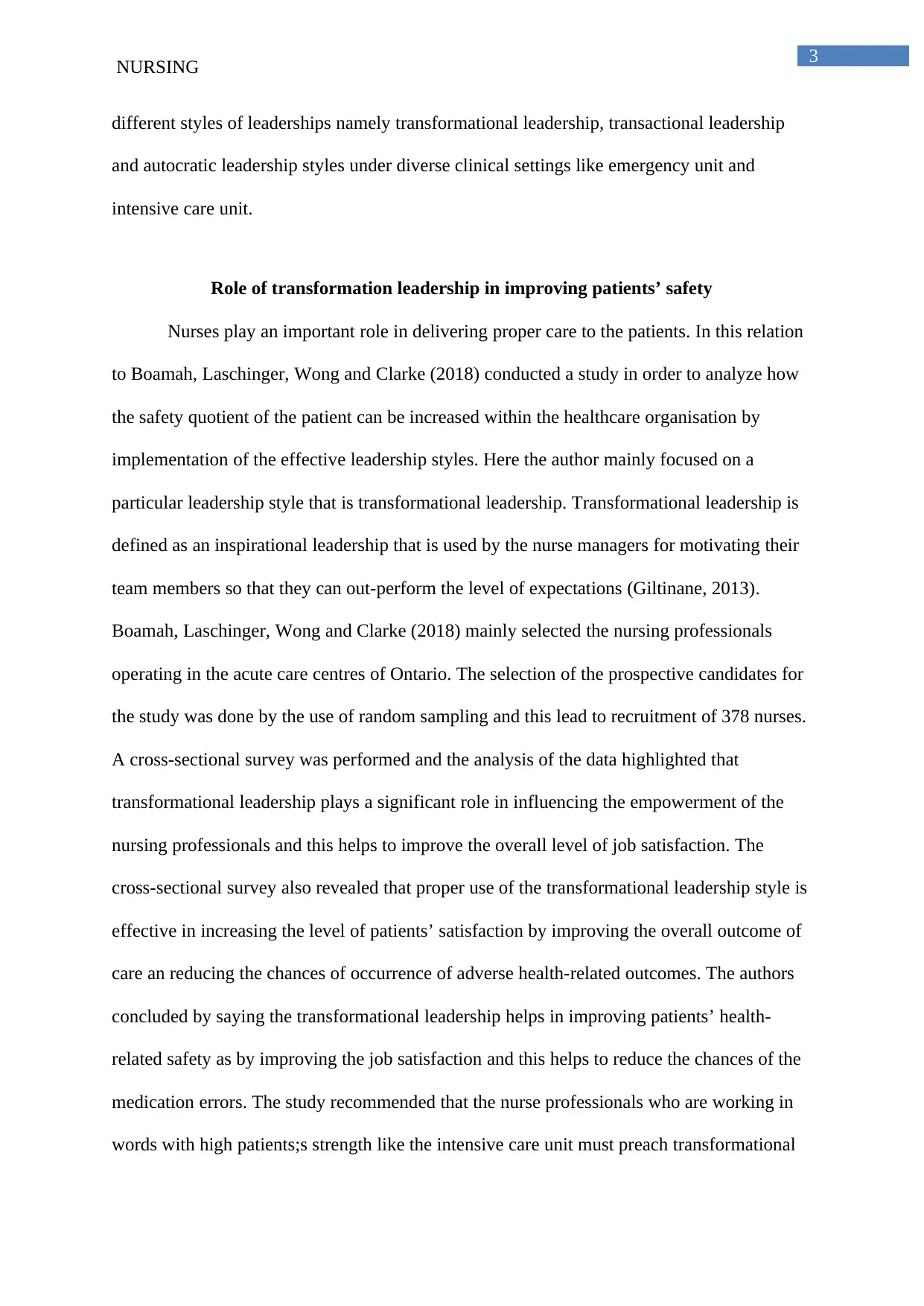
3
NURSING
different styles of leaderships namely transformational leadership, transactional leadership
and autocratic leadership styles under diverse clinical settings like emergency unit and
intensive care unit.
Role of transformation leadership in improving patients’ safety
Nurses play an important role in delivering proper care to the patients. In this relation
to Boamah, Laschinger, Wong and Clarke (2018) conducted a study in order to analyze how
the safety quotient of the patient can be increased within the healthcare organisation by
implementation of the effective leadership styles. Here the author mainly focused on a
particular leadership style that is transformational leadership. Transformational leadership is
defined as an inspirational leadership that is used by the nurse managers for motivating their
team members so that they can out-perform the level of expectations (Giltinane, 2013).
Boamah, Laschinger, Wong and Clarke (2018) mainly selected the nursing professionals
operating in the acute care centres of Ontario. The selection of the prospective candidates for
the study was done by the use of random sampling and this lead to recruitment of 378 nurses.
A cross-sectional survey was performed and the analysis of the data highlighted that
transformational leadership plays a significant role in influencing the empowerment of the
nursing professionals and this helps to improve the overall level of job satisfaction. The
cross-sectional survey also revealed that proper use of the transformational leadership style is
effective in increasing the level of patients’ satisfaction by improving the overall outcome of
care an reducing the chances of occurrence of adverse health-related outcomes. The authors
concluded by saying the transformational leadership helps in improving patients’ health-
related safety as by improving the job satisfaction and this helps to reduce the chances of the
medication errors. The study recommended that the nurse professionals who are working in
words with high patients;s strength like the intensive care unit must preach transformational
NURSING
different styles of leaderships namely transformational leadership, transactional leadership
and autocratic leadership styles under diverse clinical settings like emergency unit and
intensive care unit.
Role of transformation leadership in improving patients’ safety
Nurses play an important role in delivering proper care to the patients. In this relation
to Boamah, Laschinger, Wong and Clarke (2018) conducted a study in order to analyze how
the safety quotient of the patient can be increased within the healthcare organisation by
implementation of the effective leadership styles. Here the author mainly focused on a
particular leadership style that is transformational leadership. Transformational leadership is
defined as an inspirational leadership that is used by the nurse managers for motivating their
team members so that they can out-perform the level of expectations (Giltinane, 2013).
Boamah, Laschinger, Wong and Clarke (2018) mainly selected the nursing professionals
operating in the acute care centres of Ontario. The selection of the prospective candidates for
the study was done by the use of random sampling and this lead to recruitment of 378 nurses.
A cross-sectional survey was performed and the analysis of the data highlighted that
transformational leadership plays a significant role in influencing the empowerment of the
nursing professionals and this helps to improve the overall level of job satisfaction. The
cross-sectional survey also revealed that proper use of the transformational leadership style is
effective in increasing the level of patients’ satisfaction by improving the overall outcome of
care an reducing the chances of occurrence of adverse health-related outcomes. The authors
concluded by saying the transformational leadership helps in improving patients’ health-
related safety as by improving the job satisfaction and this helps to reduce the chances of the
medication errors. The study recommended that the nurse professionals who are working in
words with high patients;s strength like the intensive care unit must preach transformational
⊘ This is a preview!⊘
Do you want full access?
Subscribe today to unlock all pages.

Trusted by 1+ million students worldwide
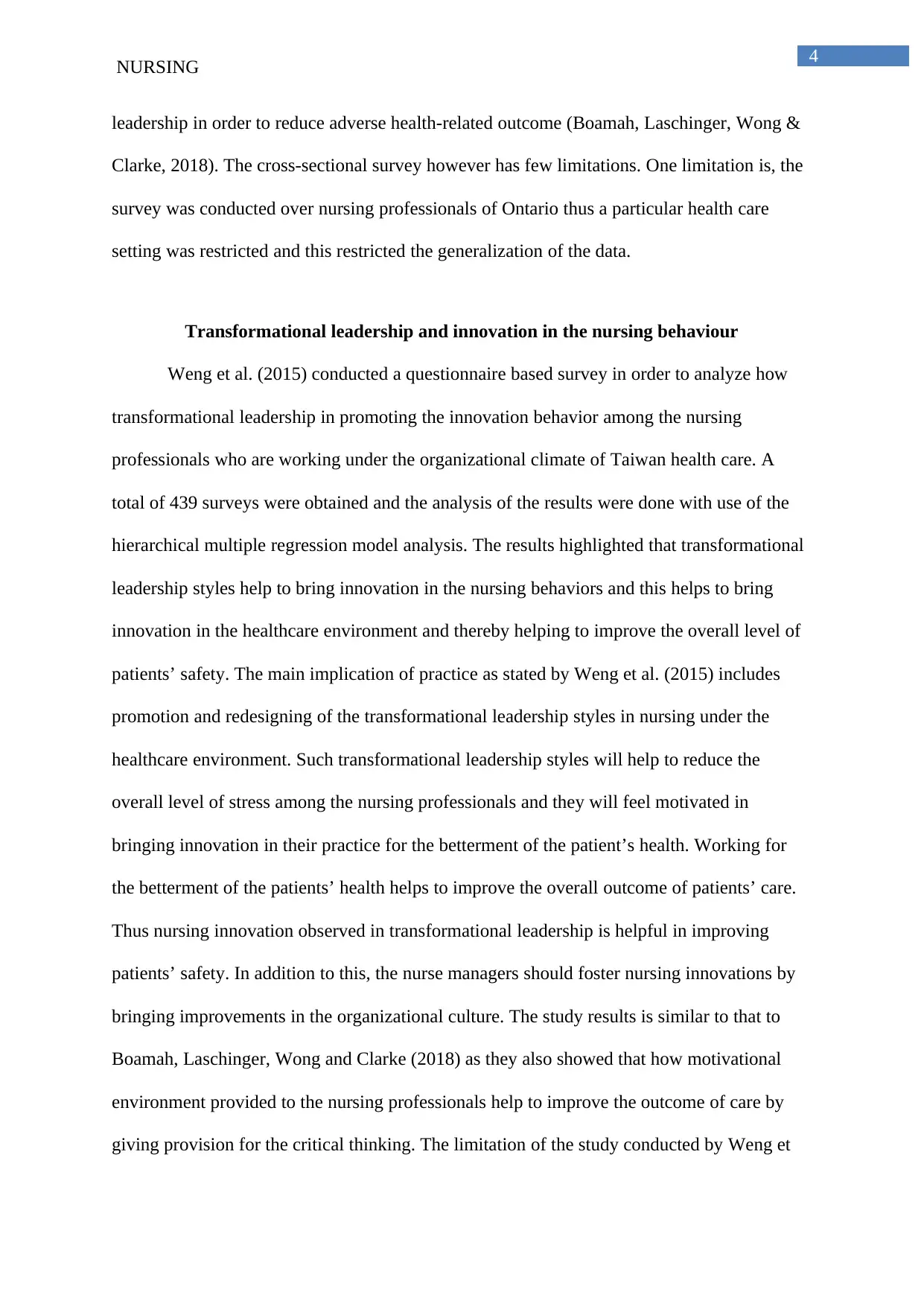
4
NURSING
leadership in order to reduce adverse health-related outcome (Boamah, Laschinger, Wong &
Clarke, 2018). The cross-sectional survey however has few limitations. One limitation is, the
survey was conducted over nursing professionals of Ontario thus a particular health care
setting was restricted and this restricted the generalization of the data.
Transformational leadership and innovation in the nursing behaviour
Weng et al. (2015) conducted a questionnaire based survey in order to analyze how
transformational leadership in promoting the innovation behavior among the nursing
professionals who are working under the organizational climate of Taiwan health care. A
total of 439 surveys were obtained and the analysis of the results were done with use of the
hierarchical multiple regression model analysis. The results highlighted that transformational
leadership styles help to bring innovation in the nursing behaviors and this helps to bring
innovation in the healthcare environment and thereby helping to improve the overall level of
patients’ safety. The main implication of practice as stated by Weng et al. (2015) includes
promotion and redesigning of the transformational leadership styles in nursing under the
healthcare environment. Such transformational leadership styles will help to reduce the
overall level of stress among the nursing professionals and they will feel motivated in
bringing innovation in their practice for the betterment of the patient’s health. Working for
the betterment of the patients’ health helps to improve the overall outcome of patients’ care.
Thus nursing innovation observed in transformational leadership is helpful in improving
patients’ safety. In addition to this, the nurse managers should foster nursing innovations by
bringing improvements in the organizational culture. The study results is similar to that to
Boamah, Laschinger, Wong and Clarke (2018) as they also showed that how motivational
environment provided to the nursing professionals help to improve the outcome of care by
giving provision for the critical thinking. The limitation of the study conducted by Weng et
NURSING
leadership in order to reduce adverse health-related outcome (Boamah, Laschinger, Wong &
Clarke, 2018). The cross-sectional survey however has few limitations. One limitation is, the
survey was conducted over nursing professionals of Ontario thus a particular health care
setting was restricted and this restricted the generalization of the data.
Transformational leadership and innovation in the nursing behaviour
Weng et al. (2015) conducted a questionnaire based survey in order to analyze how
transformational leadership in promoting the innovation behavior among the nursing
professionals who are working under the organizational climate of Taiwan health care. A
total of 439 surveys were obtained and the analysis of the results were done with use of the
hierarchical multiple regression model analysis. The results highlighted that transformational
leadership styles help to bring innovation in the nursing behaviors and this helps to bring
innovation in the healthcare environment and thereby helping to improve the overall level of
patients’ safety. The main implication of practice as stated by Weng et al. (2015) includes
promotion and redesigning of the transformational leadership styles in nursing under the
healthcare environment. Such transformational leadership styles will help to reduce the
overall level of stress among the nursing professionals and they will feel motivated in
bringing innovation in their practice for the betterment of the patient’s health. Working for
the betterment of the patients’ health helps to improve the overall outcome of patients’ care.
Thus nursing innovation observed in transformational leadership is helpful in improving
patients’ safety. In addition to this, the nurse managers should foster nursing innovations by
bringing improvements in the organizational culture. The study results is similar to that to
Boamah, Laschinger, Wong and Clarke (2018) as they also showed that how motivational
environment provided to the nursing professionals help to improve the outcome of care by
giving provision for the critical thinking. The limitation of the study conducted by Weng et
Paraphrase This Document
Need a fresh take? Get an instant paraphrase of this document with our AI Paraphraser
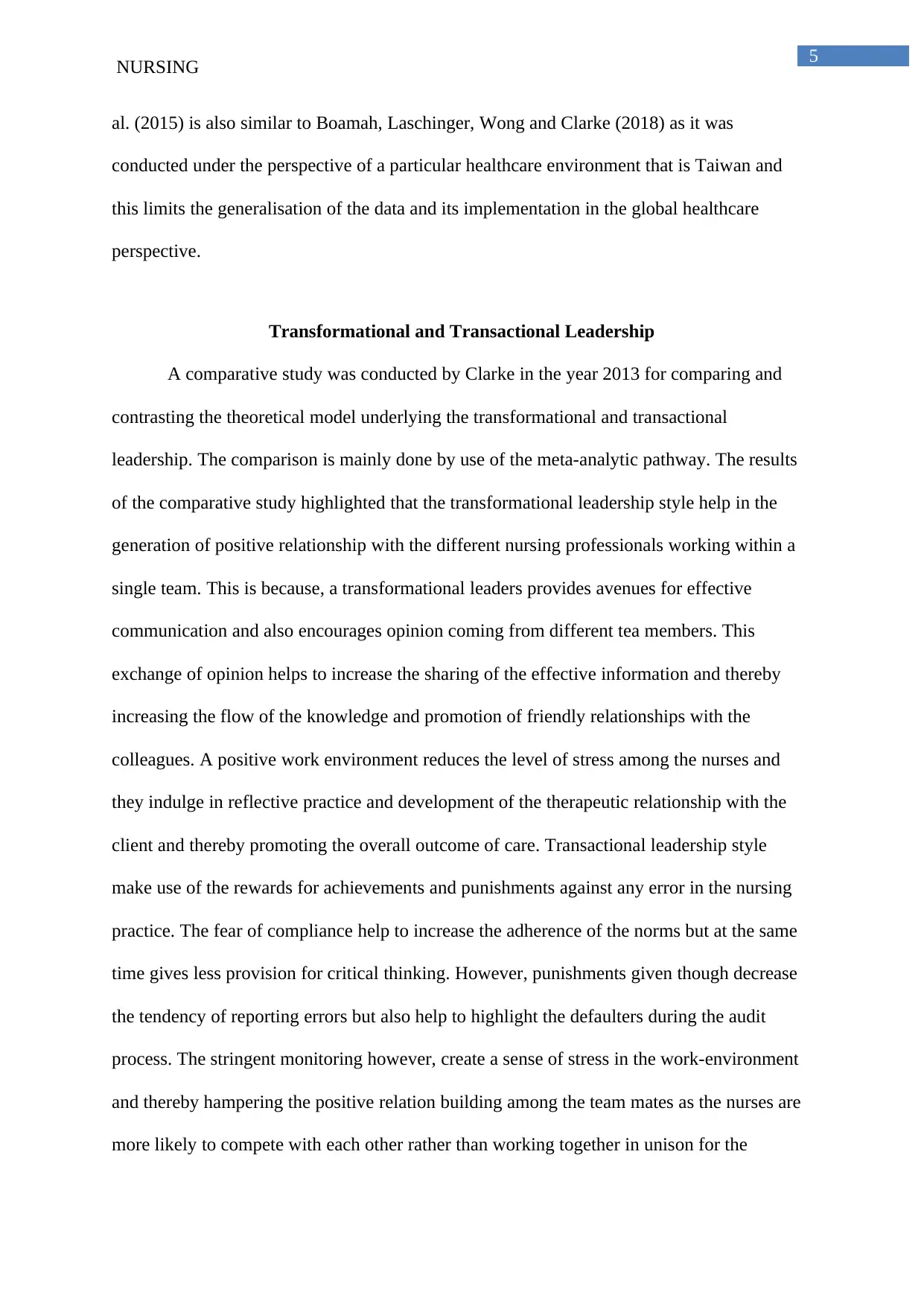
5
NURSING
al. (2015) is also similar to Boamah, Laschinger, Wong and Clarke (2018) as it was
conducted under the perspective of a particular healthcare environment that is Taiwan and
this limits the generalisation of the data and its implementation in the global healthcare
perspective.
Transformational and Transactional Leadership
A comparative study was conducted by Clarke in the year 2013 for comparing and
contrasting the theoretical model underlying the transformational and transactional
leadership. The comparison is mainly done by use of the meta-analytic pathway. The results
of the comparative study highlighted that the transformational leadership style help in the
generation of positive relationship with the different nursing professionals working within a
single team. This is because, a transformational leaders provides avenues for effective
communication and also encourages opinion coming from different tea members. This
exchange of opinion helps to increase the sharing of the effective information and thereby
increasing the flow of the knowledge and promotion of friendly relationships with the
colleagues. A positive work environment reduces the level of stress among the nurses and
they indulge in reflective practice and development of the therapeutic relationship with the
client and thereby promoting the overall outcome of care. Transactional leadership style
make use of the rewards for achievements and punishments against any error in the nursing
practice. The fear of compliance help to increase the adherence of the norms but at the same
time gives less provision for critical thinking. However, punishments given though decrease
the tendency of reporting errors but also help to highlight the defaulters during the audit
process. The stringent monitoring however, create a sense of stress in the work-environment
and thereby hampering the positive relation building among the team mates as the nurses are
more likely to compete with each other rather than working together in unison for the
NURSING
al. (2015) is also similar to Boamah, Laschinger, Wong and Clarke (2018) as it was
conducted under the perspective of a particular healthcare environment that is Taiwan and
this limits the generalisation of the data and its implementation in the global healthcare
perspective.
Transformational and Transactional Leadership
A comparative study was conducted by Clarke in the year 2013 for comparing and
contrasting the theoretical model underlying the transformational and transactional
leadership. The comparison is mainly done by use of the meta-analytic pathway. The results
of the comparative study highlighted that the transformational leadership style help in the
generation of positive relationship with the different nursing professionals working within a
single team. This is because, a transformational leaders provides avenues for effective
communication and also encourages opinion coming from different tea members. This
exchange of opinion helps to increase the sharing of the effective information and thereby
increasing the flow of the knowledge and promotion of friendly relationships with the
colleagues. A positive work environment reduces the level of stress among the nurses and
they indulge in reflective practice and development of the therapeutic relationship with the
client and thereby promoting the overall outcome of care. Transactional leadership style
make use of the rewards for achievements and punishments against any error in the nursing
practice. The fear of compliance help to increase the adherence of the norms but at the same
time gives less provision for critical thinking. However, punishments given though decrease
the tendency of reporting errors but also help to highlight the defaulters during the audit
process. The stringent monitoring however, create a sense of stress in the work-environment
and thereby hampering the positive relation building among the team mates as the nurses are
more likely to compete with each other rather than working together in unison for the
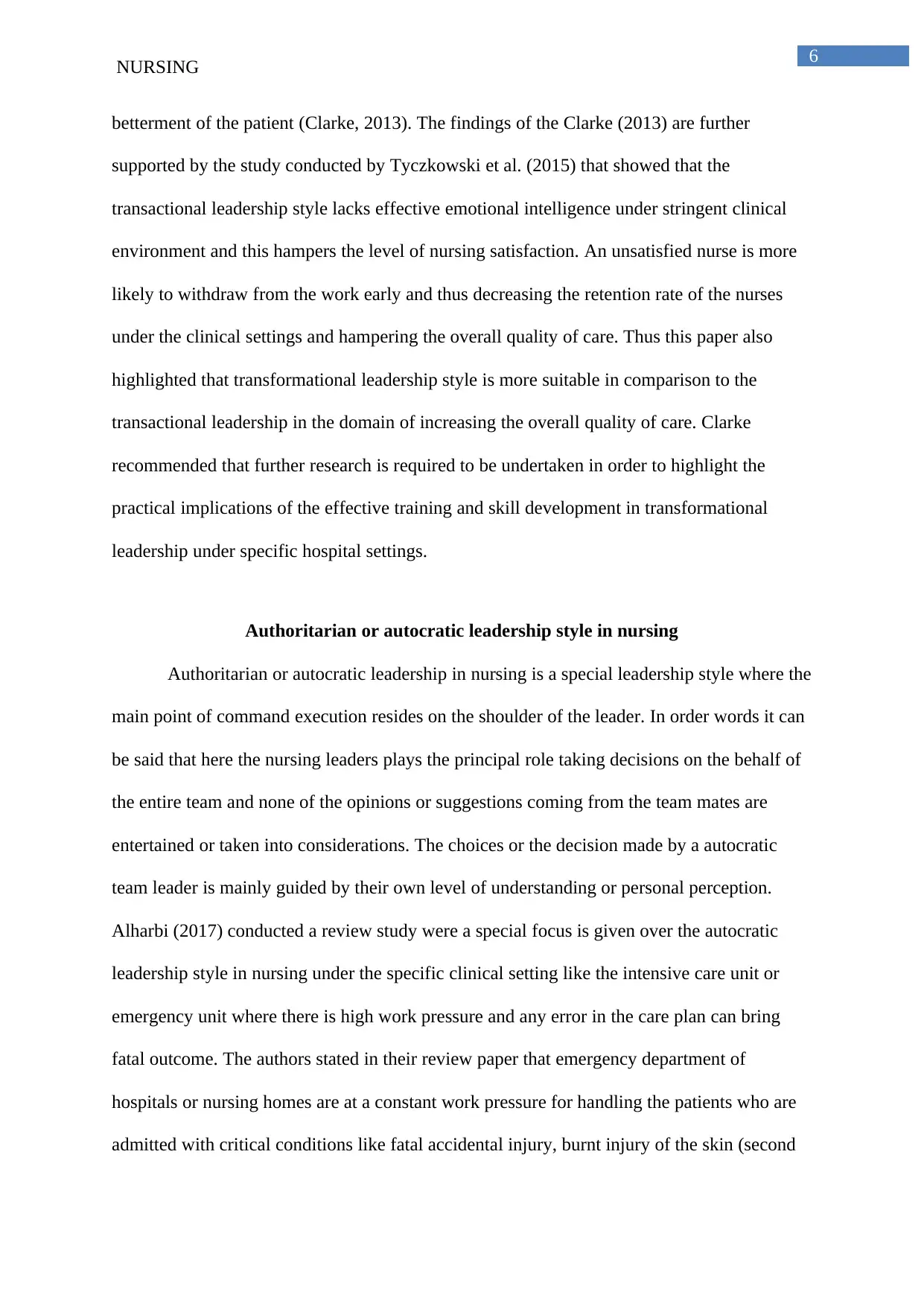
6
NURSING
betterment of the patient (Clarke, 2013). The findings of the Clarke (2013) are further
supported by the study conducted by Tyczkowski et al. (2015) that showed that the
transactional leadership style lacks effective emotional intelligence under stringent clinical
environment and this hampers the level of nursing satisfaction. An unsatisfied nurse is more
likely to withdraw from the work early and thus decreasing the retention rate of the nurses
under the clinical settings and hampering the overall quality of care. Thus this paper also
highlighted that transformational leadership style is more suitable in comparison to the
transactional leadership in the domain of increasing the overall quality of care. Clarke
recommended that further research is required to be undertaken in order to highlight the
practical implications of the effective training and skill development in transformational
leadership under specific hospital settings.
Authoritarian or autocratic leadership style in nursing
Authoritarian or autocratic leadership in nursing is a special leadership style where the
main point of command execution resides on the shoulder of the leader. In order words it can
be said that here the nursing leaders plays the principal role taking decisions on the behalf of
the entire team and none of the opinions or suggestions coming from the team mates are
entertained or taken into considerations. The choices or the decision made by a autocratic
team leader is mainly guided by their own level of understanding or personal perception.
Alharbi (2017) conducted a review study were a special focus is given over the autocratic
leadership style in nursing under the specific clinical setting like the intensive care unit or
emergency unit where there is high work pressure and any error in the care plan can bring
fatal outcome. The authors stated in their review paper that emergency department of
hospitals or nursing homes are at a constant work pressure for handling the patients who are
admitted with critical conditions like fatal accidental injury, burnt injury of the skin (second
NURSING
betterment of the patient (Clarke, 2013). The findings of the Clarke (2013) are further
supported by the study conducted by Tyczkowski et al. (2015) that showed that the
transactional leadership style lacks effective emotional intelligence under stringent clinical
environment and this hampers the level of nursing satisfaction. An unsatisfied nurse is more
likely to withdraw from the work early and thus decreasing the retention rate of the nurses
under the clinical settings and hampering the overall quality of care. Thus this paper also
highlighted that transformational leadership style is more suitable in comparison to the
transactional leadership in the domain of increasing the overall quality of care. Clarke
recommended that further research is required to be undertaken in order to highlight the
practical implications of the effective training and skill development in transformational
leadership under specific hospital settings.
Authoritarian or autocratic leadership style in nursing
Authoritarian or autocratic leadership in nursing is a special leadership style where the
main point of command execution resides on the shoulder of the leader. In order words it can
be said that here the nursing leaders plays the principal role taking decisions on the behalf of
the entire team and none of the opinions or suggestions coming from the team mates are
entertained or taken into considerations. The choices or the decision made by a autocratic
team leader is mainly guided by their own level of understanding or personal perception.
Alharbi (2017) conducted a review study were a special focus is given over the autocratic
leadership style in nursing under the specific clinical setting like the intensive care unit or
emergency unit where there is high work pressure and any error in the care plan can bring
fatal outcome. The authors stated in their review paper that emergency department of
hospitals or nursing homes are at a constant work pressure for handling the patients who are
admitted with critical conditions like fatal accidental injury, burnt injury of the skin (second
⊘ This is a preview!⊘
Do you want full access?
Subscribe today to unlock all pages.

Trusted by 1+ million students worldwide
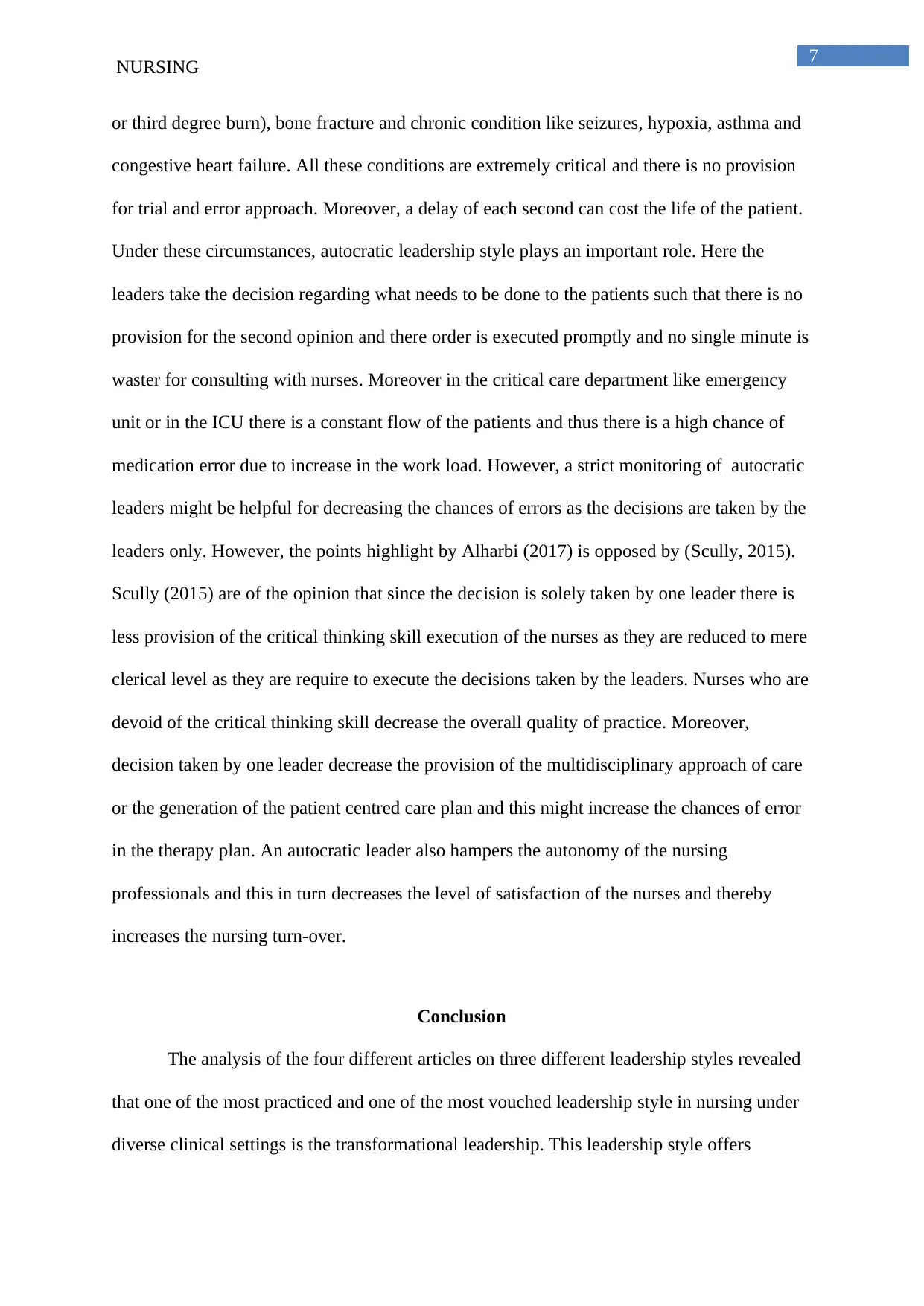
7
NURSING
or third degree burn), bone fracture and chronic condition like seizures, hypoxia, asthma and
congestive heart failure. All these conditions are extremely critical and there is no provision
for trial and error approach. Moreover, a delay of each second can cost the life of the patient.
Under these circumstances, autocratic leadership style plays an important role. Here the
leaders take the decision regarding what needs to be done to the patients such that there is no
provision for the second opinion and there order is executed promptly and no single minute is
waster for consulting with nurses. Moreover in the critical care department like emergency
unit or in the ICU there is a constant flow of the patients and thus there is a high chance of
medication error due to increase in the work load. However, a strict monitoring of autocratic
leaders might be helpful for decreasing the chances of errors as the decisions are taken by the
leaders only. However, the points highlight by Alharbi (2017) is opposed by (Scully, 2015).
Scully (2015) are of the opinion that since the decision is solely taken by one leader there is
less provision of the critical thinking skill execution of the nurses as they are reduced to mere
clerical level as they are require to execute the decisions taken by the leaders. Nurses who are
devoid of the critical thinking skill decrease the overall quality of practice. Moreover,
decision taken by one leader decrease the provision of the multidisciplinary approach of care
or the generation of the patient centred care plan and this might increase the chances of error
in the therapy plan. An autocratic leader also hampers the autonomy of the nursing
professionals and this in turn decreases the level of satisfaction of the nurses and thereby
increases the nursing turn-over.
Conclusion
The analysis of the four different articles on three different leadership styles revealed
that one of the most practiced and one of the most vouched leadership style in nursing under
diverse clinical settings is the transformational leadership. This leadership style offers
NURSING
or third degree burn), bone fracture and chronic condition like seizures, hypoxia, asthma and
congestive heart failure. All these conditions are extremely critical and there is no provision
for trial and error approach. Moreover, a delay of each second can cost the life of the patient.
Under these circumstances, autocratic leadership style plays an important role. Here the
leaders take the decision regarding what needs to be done to the patients such that there is no
provision for the second opinion and there order is executed promptly and no single minute is
waster for consulting with nurses. Moreover in the critical care department like emergency
unit or in the ICU there is a constant flow of the patients and thus there is a high chance of
medication error due to increase in the work load. However, a strict monitoring of autocratic
leaders might be helpful for decreasing the chances of errors as the decisions are taken by the
leaders only. However, the points highlight by Alharbi (2017) is opposed by (Scully, 2015).
Scully (2015) are of the opinion that since the decision is solely taken by one leader there is
less provision of the critical thinking skill execution of the nurses as they are reduced to mere
clerical level as they are require to execute the decisions taken by the leaders. Nurses who are
devoid of the critical thinking skill decrease the overall quality of practice. Moreover,
decision taken by one leader decrease the provision of the multidisciplinary approach of care
or the generation of the patient centred care plan and this might increase the chances of error
in the therapy plan. An autocratic leader also hampers the autonomy of the nursing
professionals and this in turn decreases the level of satisfaction of the nurses and thereby
increases the nursing turn-over.
Conclusion
The analysis of the four different articles on three different leadership styles revealed
that one of the most practiced and one of the most vouched leadership style in nursing under
diverse clinical settings is the transformational leadership. This leadership style offers
Paraphrase This Document
Need a fresh take? Get an instant paraphrase of this document with our AI Paraphraser
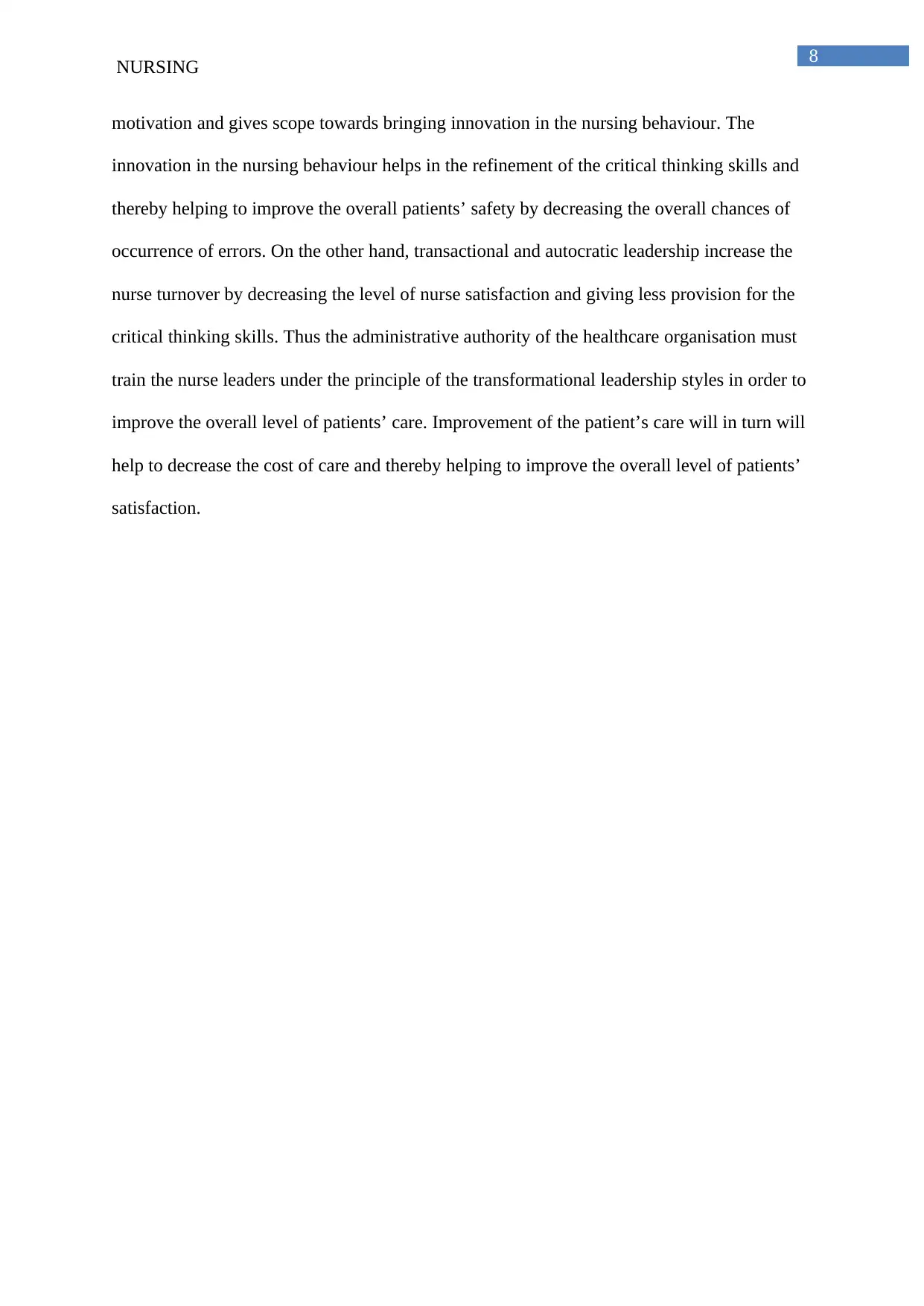
8
NURSING
motivation and gives scope towards bringing innovation in the nursing behaviour. The
innovation in the nursing behaviour helps in the refinement of the critical thinking skills and
thereby helping to improve the overall patients’ safety by decreasing the overall chances of
occurrence of errors. On the other hand, transactional and autocratic leadership increase the
nurse turnover by decreasing the level of nurse satisfaction and giving less provision for the
critical thinking skills. Thus the administrative authority of the healthcare organisation must
train the nurse leaders under the principle of the transformational leadership styles in order to
improve the overall level of patients’ care. Improvement of the patient’s care will in turn will
help to decrease the cost of care and thereby helping to improve the overall level of patients’
satisfaction.
NURSING
motivation and gives scope towards bringing innovation in the nursing behaviour. The
innovation in the nursing behaviour helps in the refinement of the critical thinking skills and
thereby helping to improve the overall patients’ safety by decreasing the overall chances of
occurrence of errors. On the other hand, transactional and autocratic leadership increase the
nurse turnover by decreasing the level of nurse satisfaction and giving less provision for the
critical thinking skills. Thus the administrative authority of the healthcare organisation must
train the nurse leaders under the principle of the transformational leadership styles in order to
improve the overall level of patients’ care. Improvement of the patient’s care will in turn will
help to decrease the cost of care and thereby helping to improve the overall level of patients’
satisfaction.
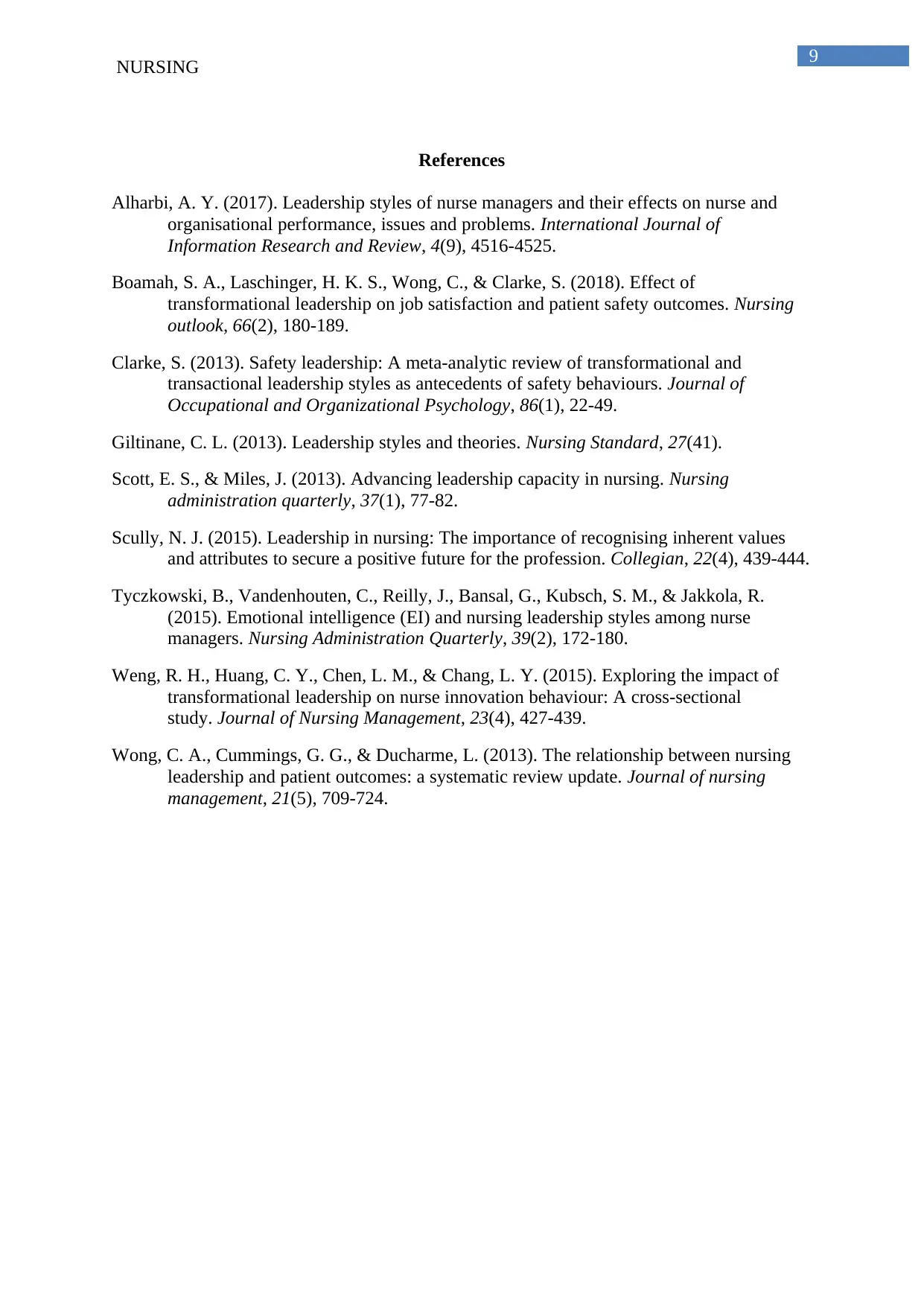
9
NURSING
References
Alharbi, A. Y. (2017). Leadership styles of nurse managers and their effects on nurse and
organisational performance, issues and problems. International Journal of
Information Research and Review, 4(9), 4516-4525.
Boamah, S. A., Laschinger, H. K. S., Wong, C., & Clarke, S. (2018). Effect of
transformational leadership on job satisfaction and patient safety outcomes. Nursing
outlook, 66(2), 180-189.
Clarke, S. (2013). Safety leadership: A meta‐analytic review of transformational and
transactional leadership styles as antecedents of safety behaviours. Journal of
Occupational and Organizational Psychology, 86(1), 22-49.
Giltinane, C. L. (2013). Leadership styles and theories. Nursing Standard, 27(41).
Scott, E. S., & Miles, J. (2013). Advancing leadership capacity in nursing. Nursing
administration quarterly, 37(1), 77-82.
Scully, N. J. (2015). Leadership in nursing: The importance of recognising inherent values
and attributes to secure a positive future for the profession. Collegian, 22(4), 439-444.
Tyczkowski, B., Vandenhouten, C., Reilly, J., Bansal, G., Kubsch, S. M., & Jakkola, R.
(2015). Emotional intelligence (EI) and nursing leadership styles among nurse
managers. Nursing Administration Quarterly, 39(2), 172-180.
Weng, R. H., Huang, C. Y., Chen, L. M., & Chang, L. Y. (2015). Exploring the impact of
transformational leadership on nurse innovation behaviour: A cross‐sectional
study. Journal of Nursing Management, 23(4), 427-439.
Wong, C. A., Cummings, G. G., & Ducharme, L. (2013). The relationship between nursing
leadership and patient outcomes: a systematic review update. Journal of nursing
management, 21(5), 709-724.
NURSING
References
Alharbi, A. Y. (2017). Leadership styles of nurse managers and their effects on nurse and
organisational performance, issues and problems. International Journal of
Information Research and Review, 4(9), 4516-4525.
Boamah, S. A., Laschinger, H. K. S., Wong, C., & Clarke, S. (2018). Effect of
transformational leadership on job satisfaction and patient safety outcomes. Nursing
outlook, 66(2), 180-189.
Clarke, S. (2013). Safety leadership: A meta‐analytic review of transformational and
transactional leadership styles as antecedents of safety behaviours. Journal of
Occupational and Organizational Psychology, 86(1), 22-49.
Giltinane, C. L. (2013). Leadership styles and theories. Nursing Standard, 27(41).
Scott, E. S., & Miles, J. (2013). Advancing leadership capacity in nursing. Nursing
administration quarterly, 37(1), 77-82.
Scully, N. J. (2015). Leadership in nursing: The importance of recognising inherent values
and attributes to secure a positive future for the profession. Collegian, 22(4), 439-444.
Tyczkowski, B., Vandenhouten, C., Reilly, J., Bansal, G., Kubsch, S. M., & Jakkola, R.
(2015). Emotional intelligence (EI) and nursing leadership styles among nurse
managers. Nursing Administration Quarterly, 39(2), 172-180.
Weng, R. H., Huang, C. Y., Chen, L. M., & Chang, L. Y. (2015). Exploring the impact of
transformational leadership on nurse innovation behaviour: A cross‐sectional
study. Journal of Nursing Management, 23(4), 427-439.
Wong, C. A., Cummings, G. G., & Ducharme, L. (2013). The relationship between nursing
leadership and patient outcomes: a systematic review update. Journal of nursing
management, 21(5), 709-724.
⊘ This is a preview!⊘
Do you want full access?
Subscribe today to unlock all pages.

Trusted by 1+ million students worldwide
1 out of 9
Related Documents
Your All-in-One AI-Powered Toolkit for Academic Success.
+13062052269
info@desklib.com
Available 24*7 on WhatsApp / Email
![[object Object]](/_next/static/media/star-bottom.7253800d.svg)
Unlock your academic potential
Copyright © 2020–2025 A2Z Services. All Rights Reserved. Developed and managed by ZUCOL.





